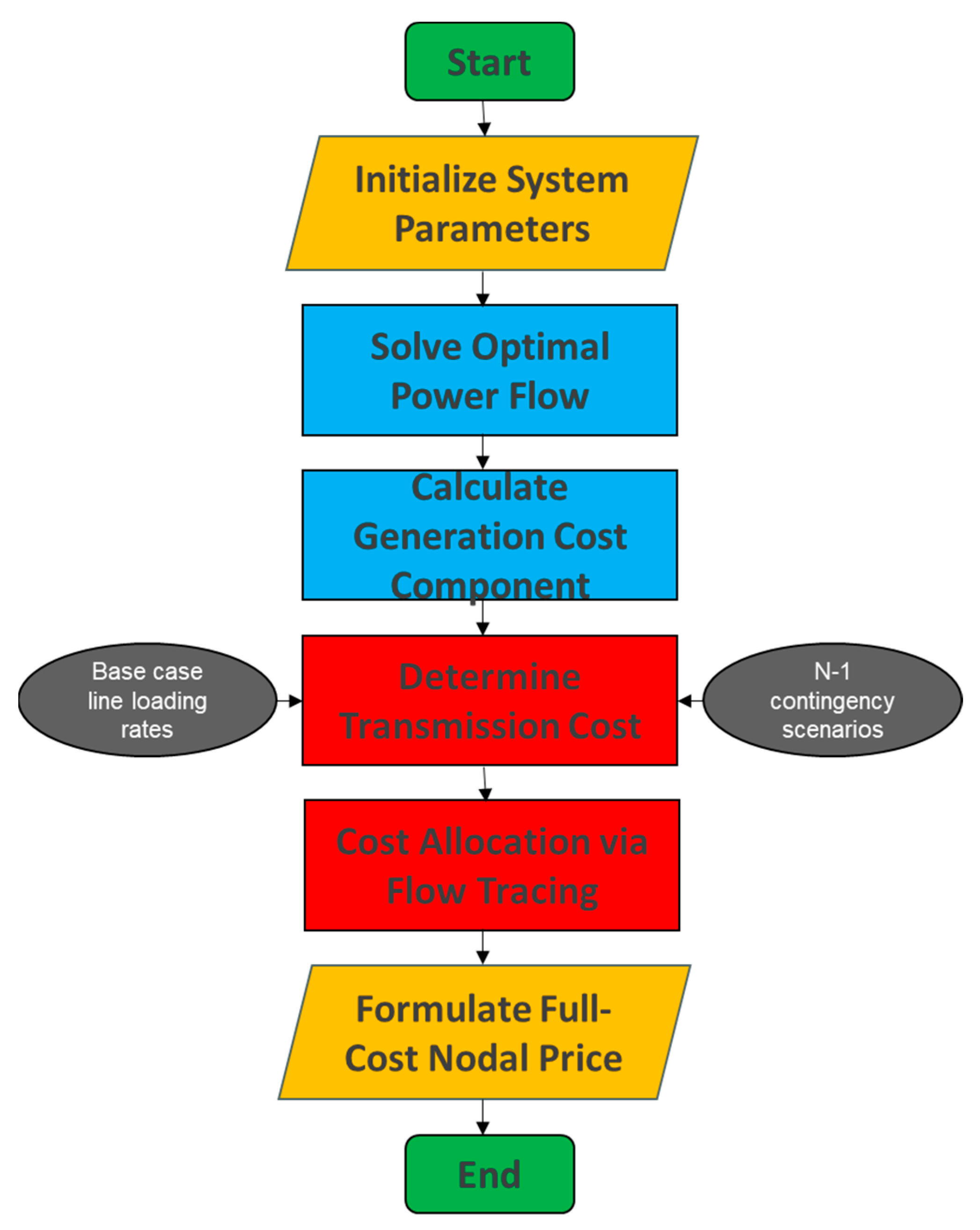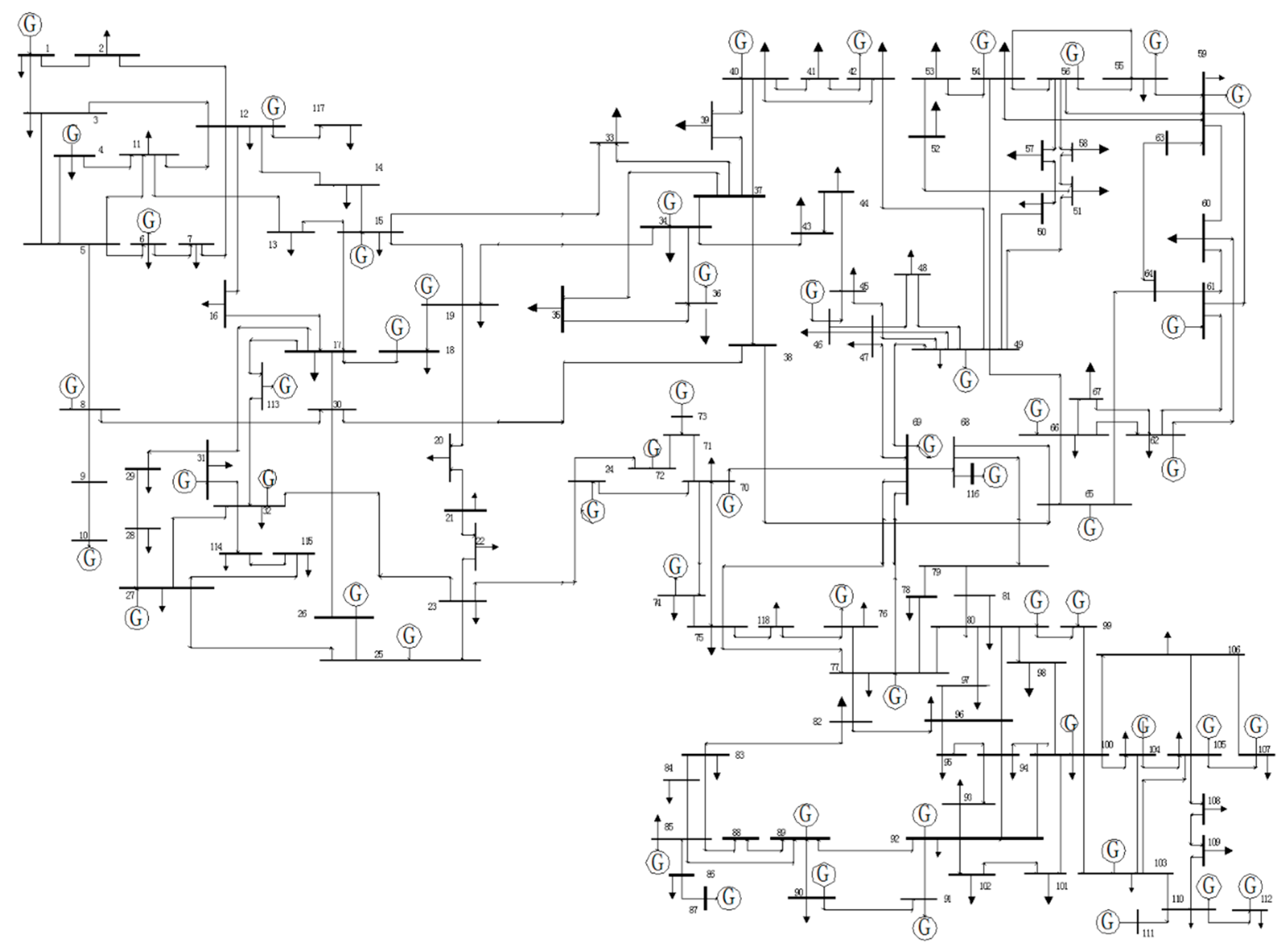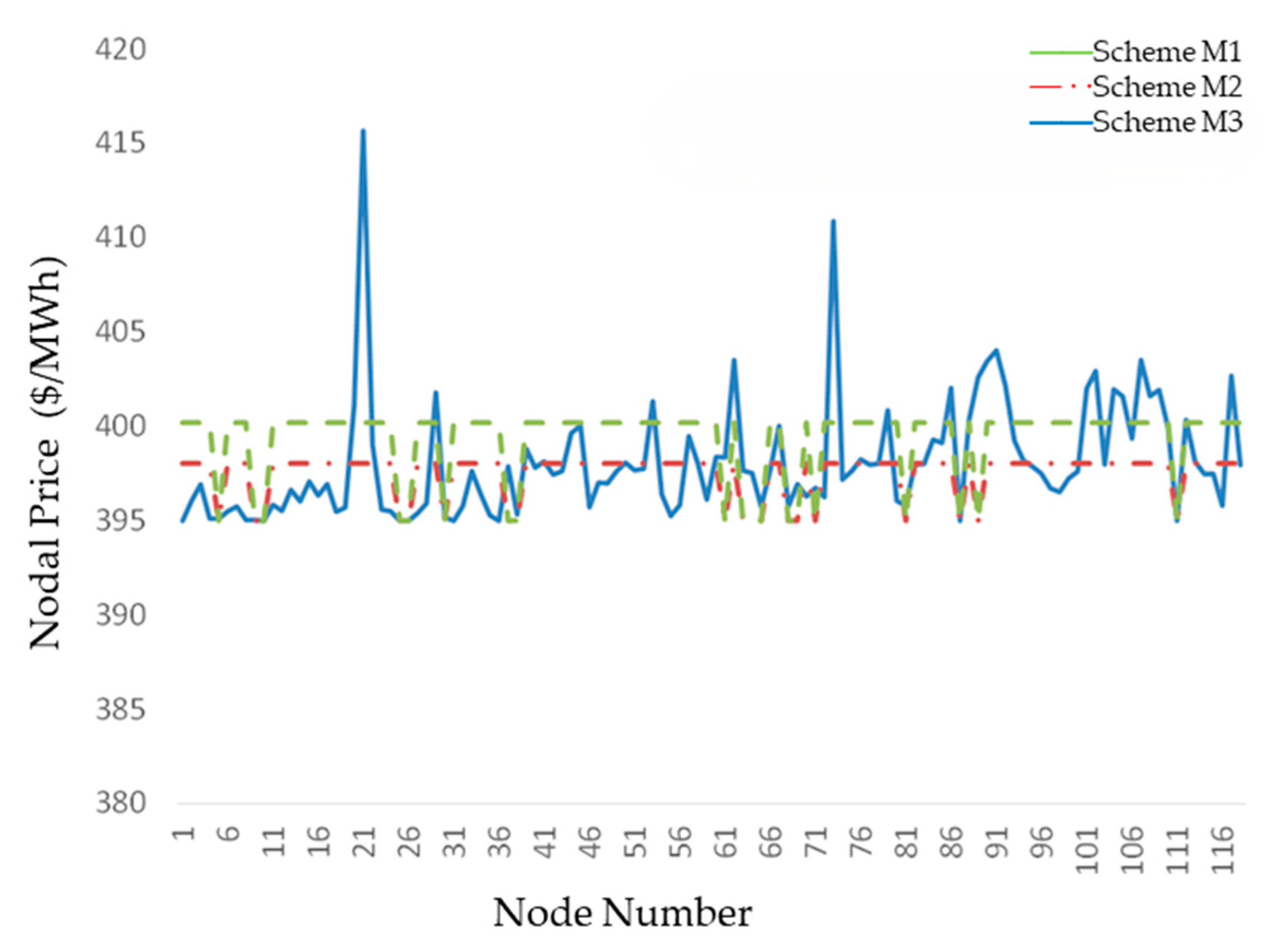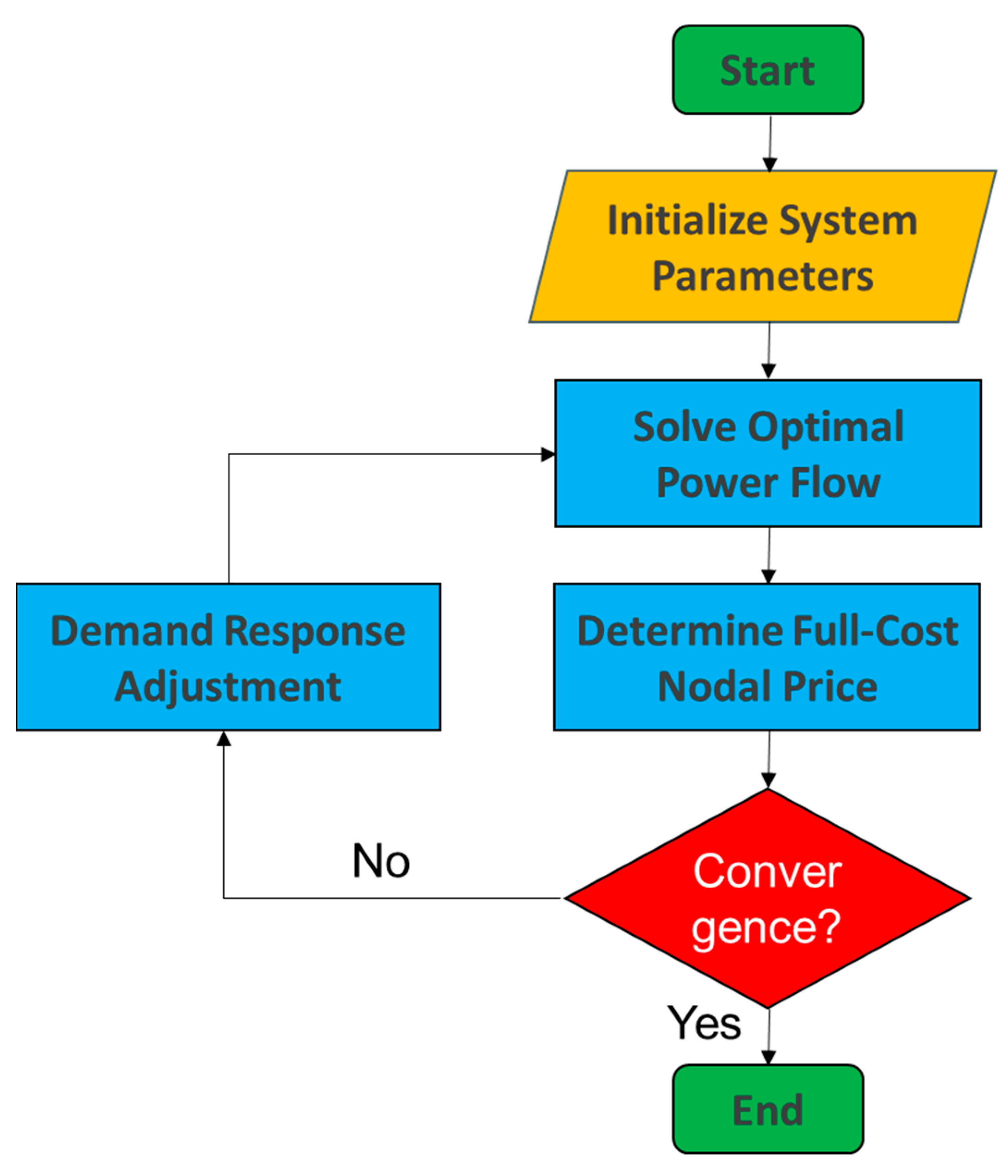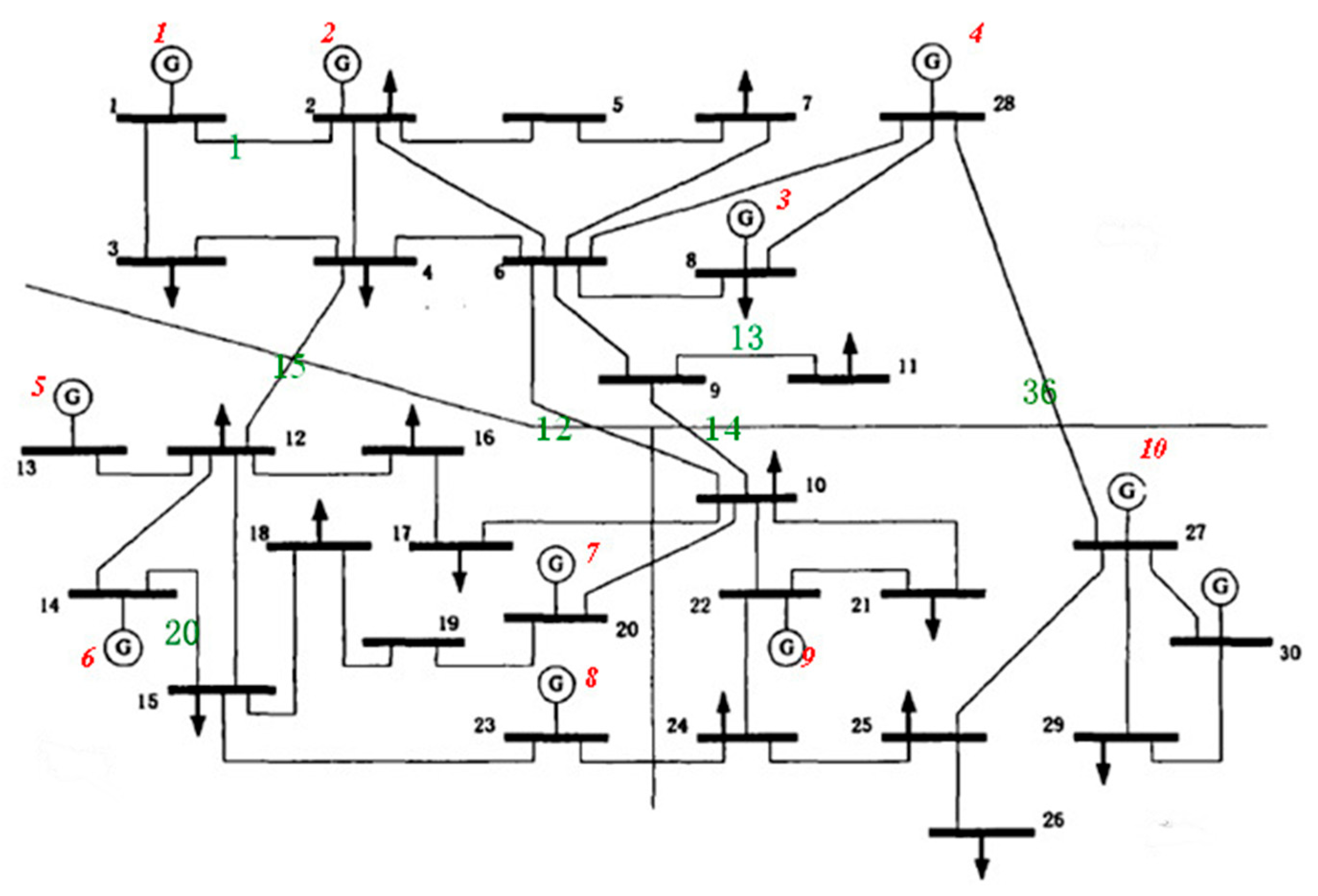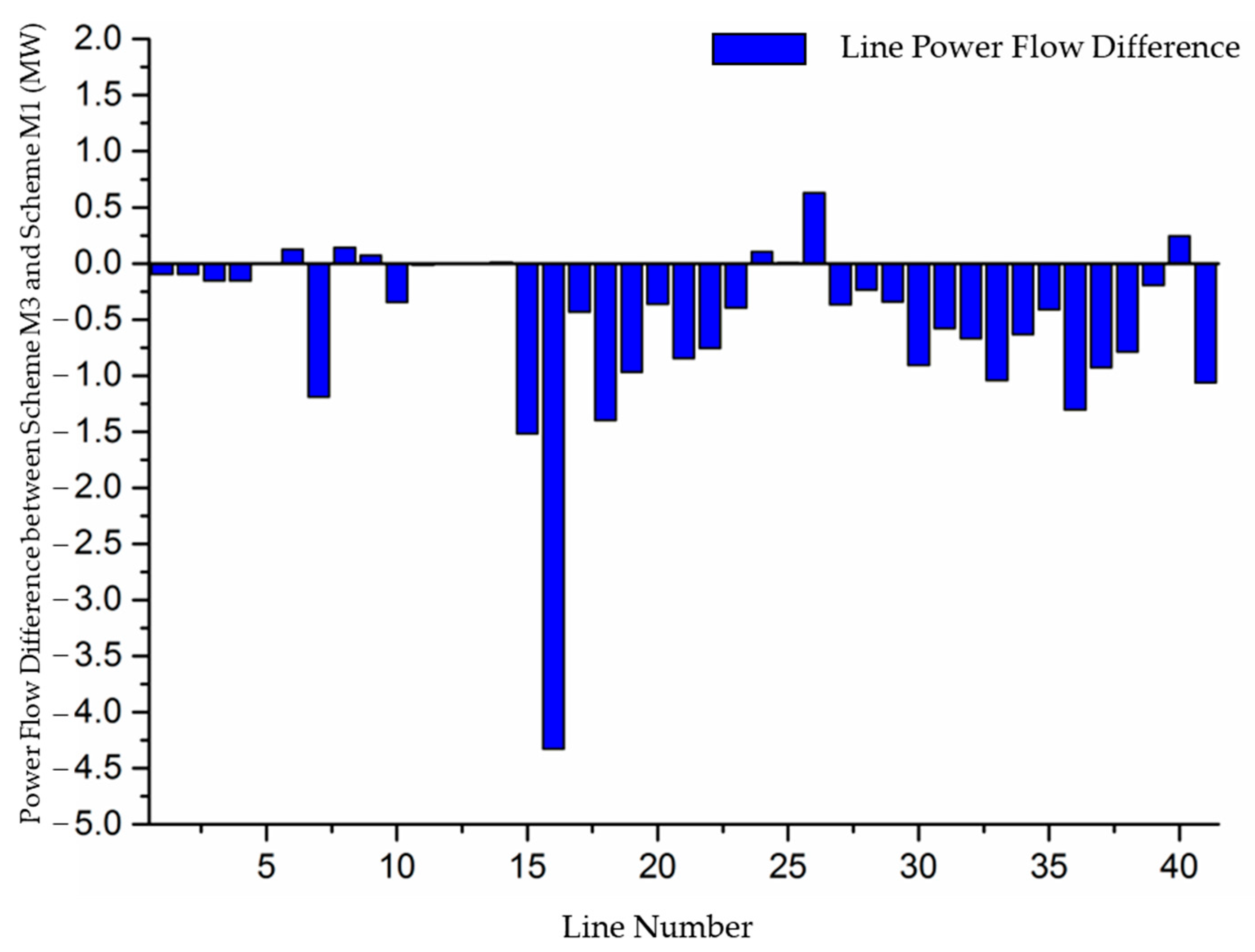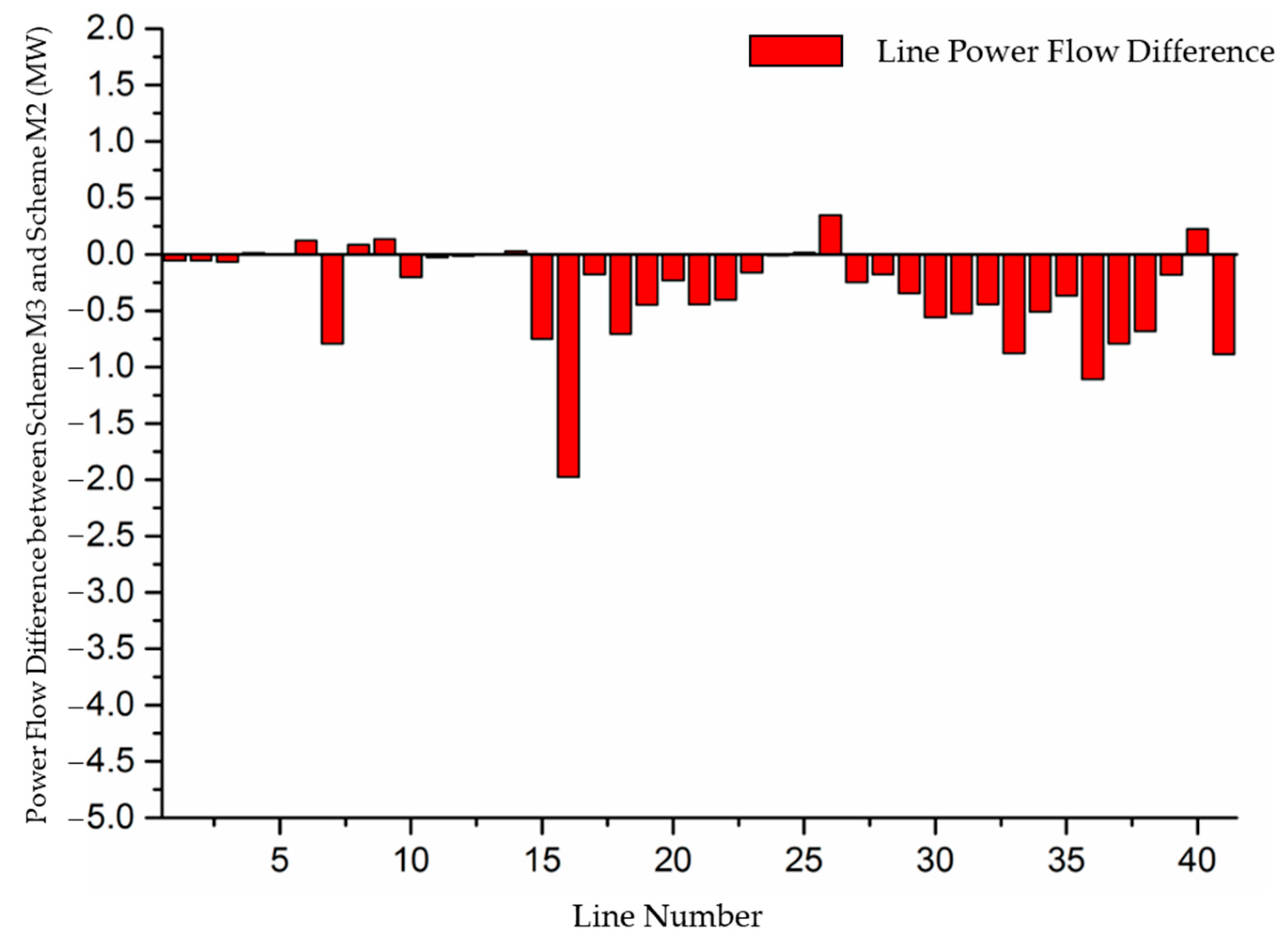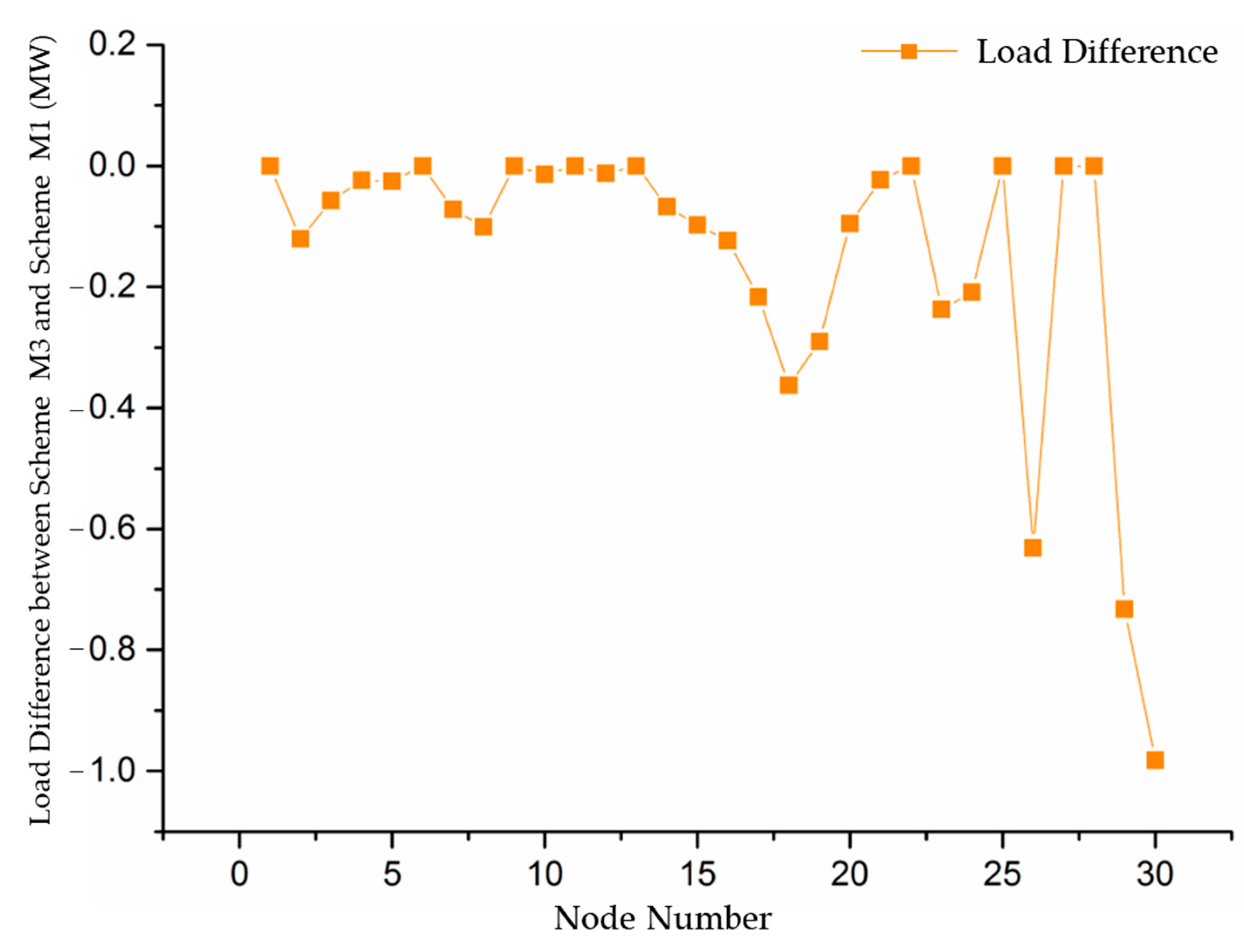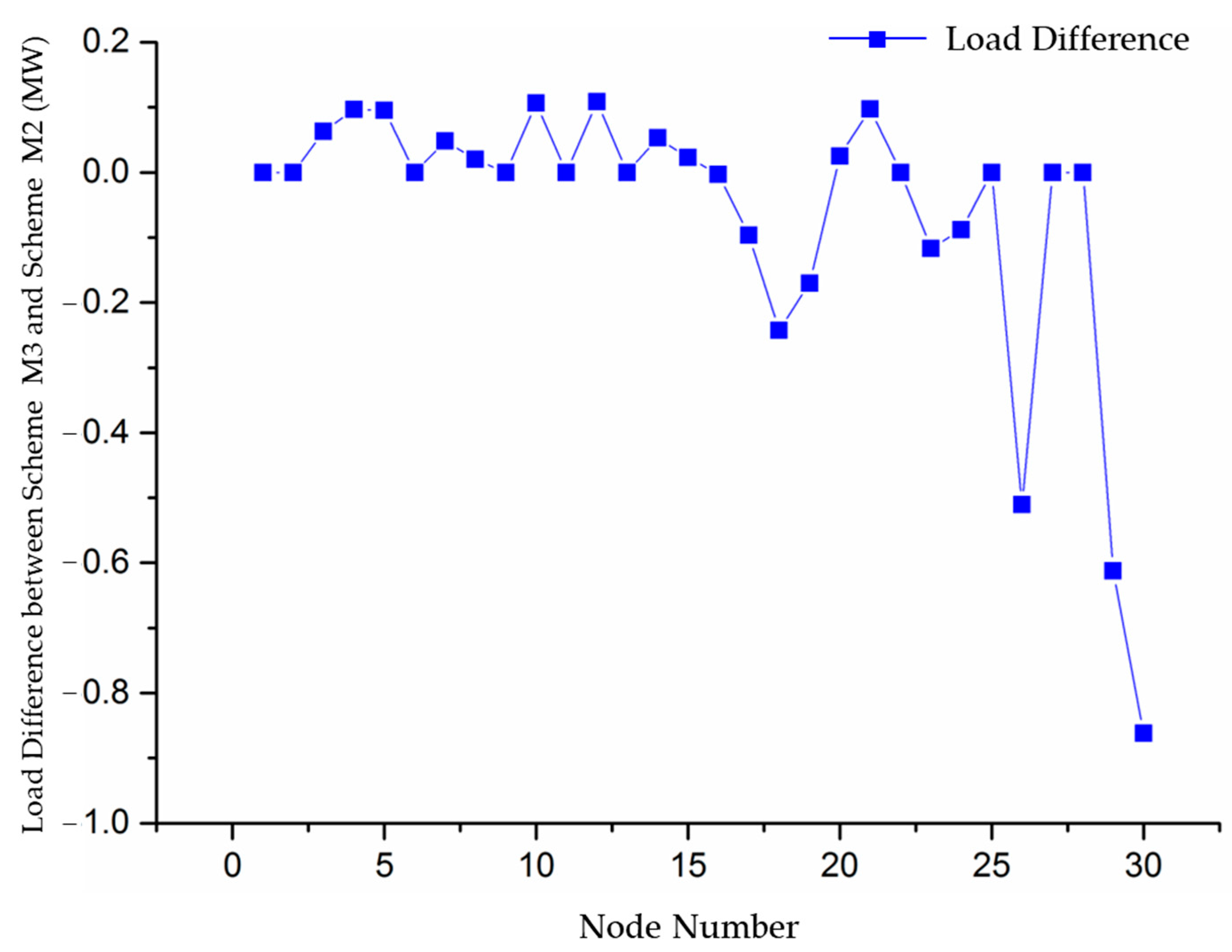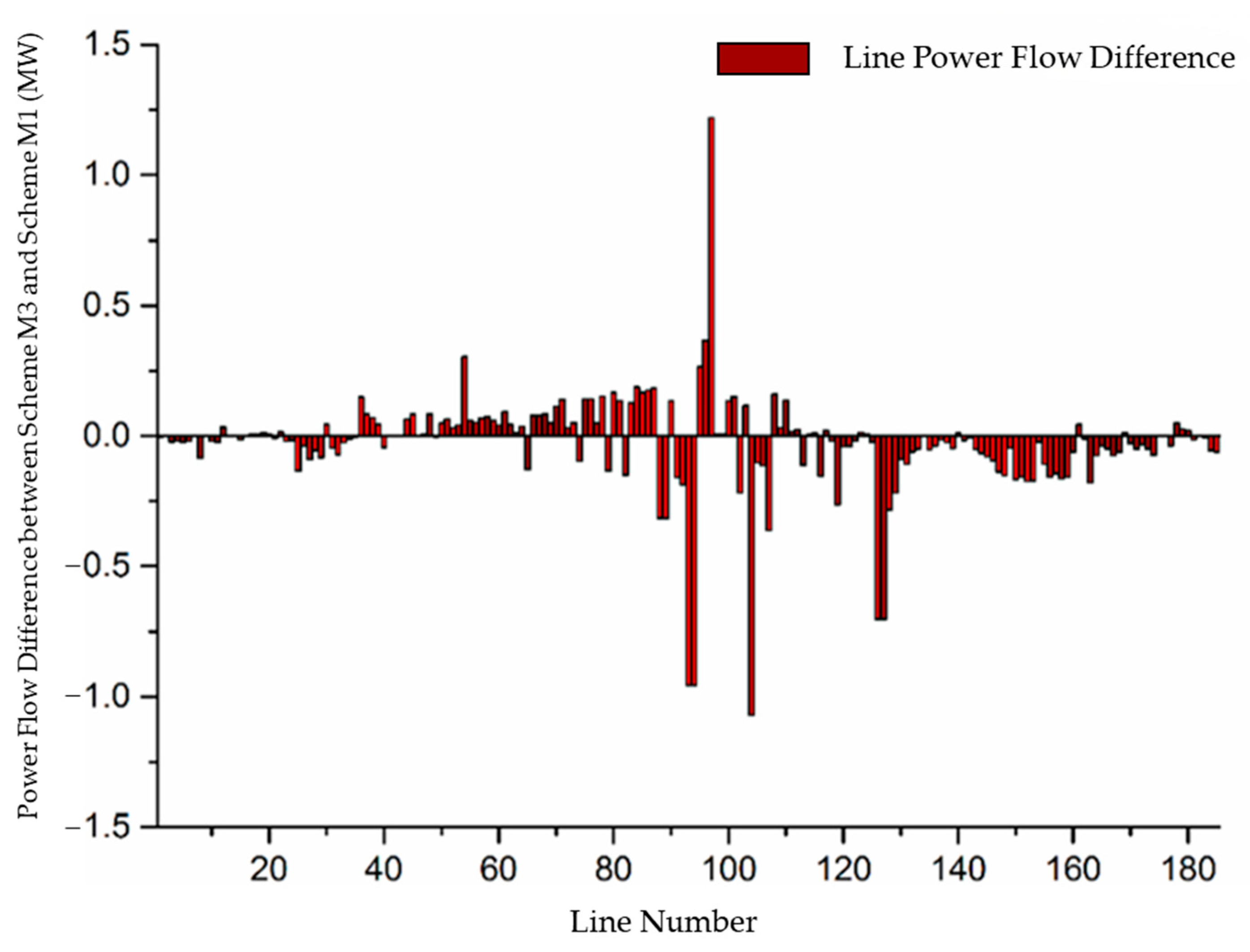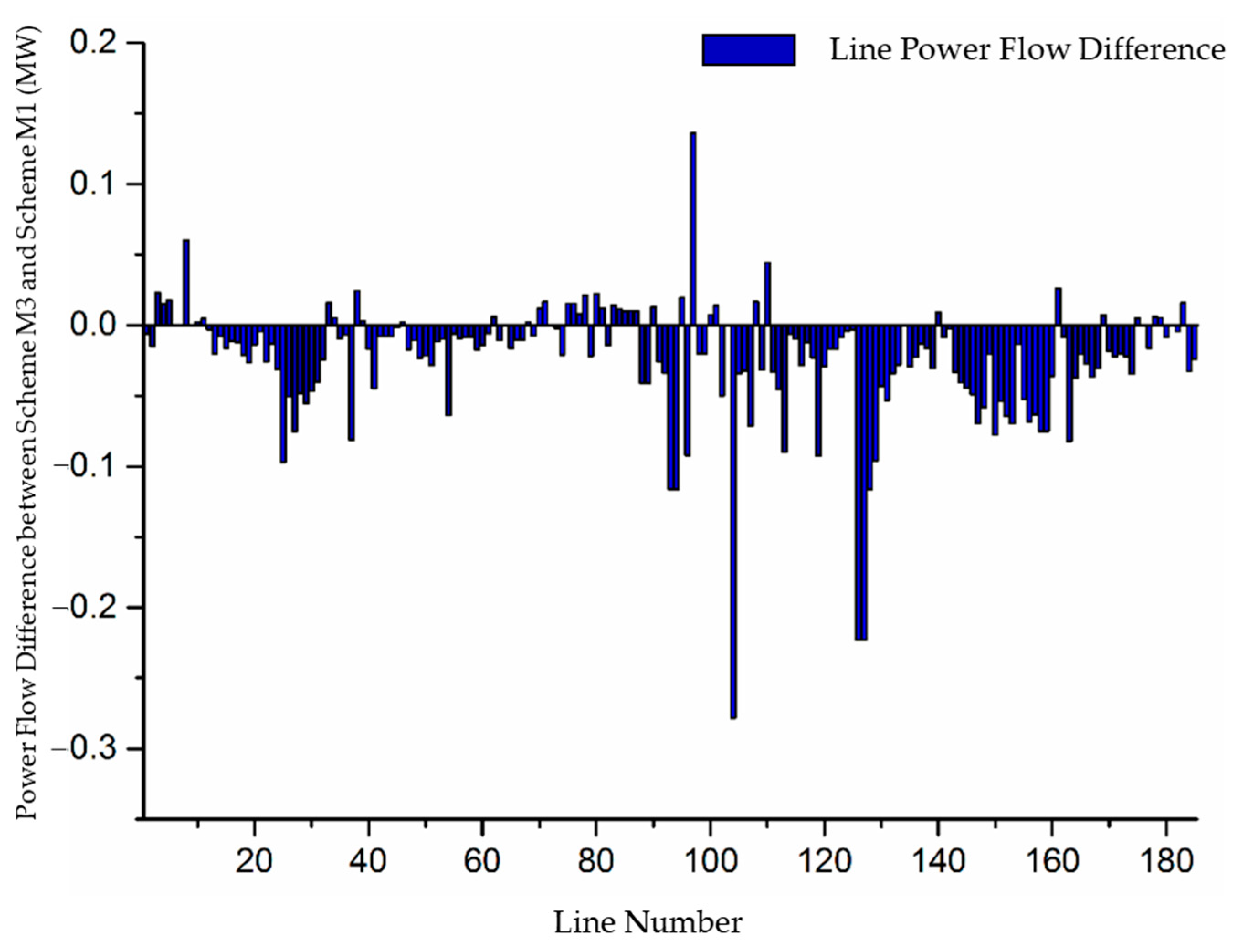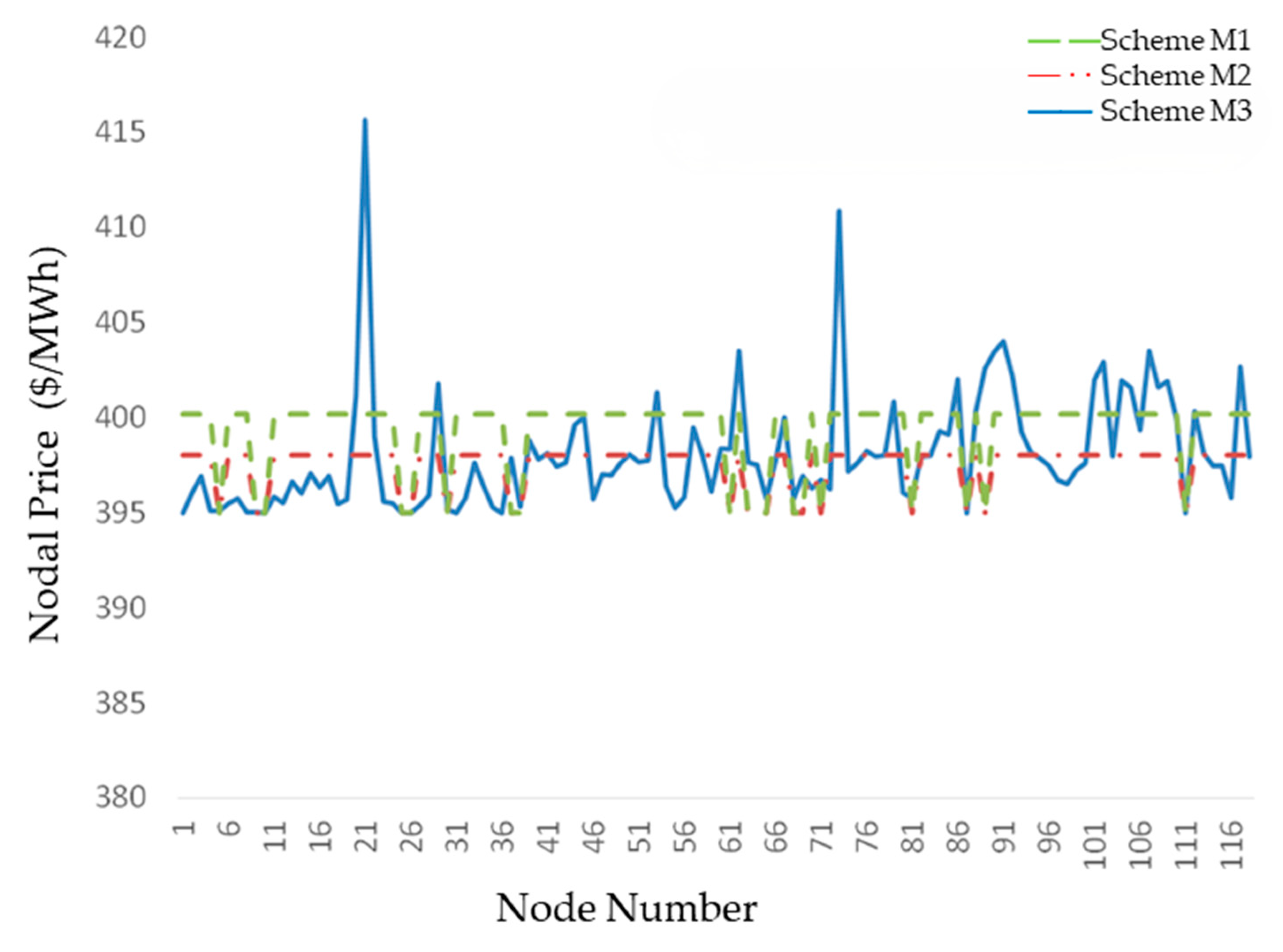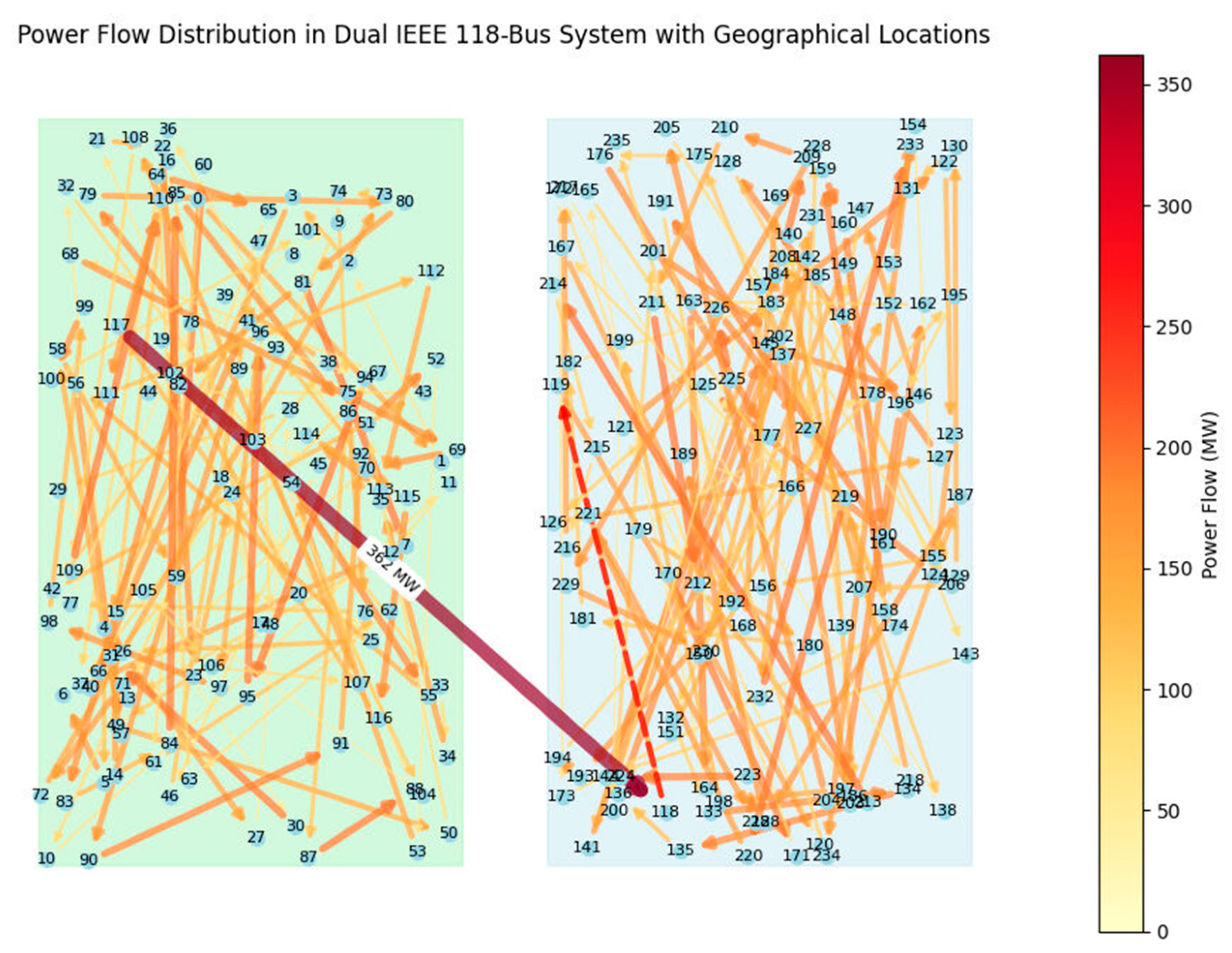3.1. Case Study on Power Flow Tracing Model
To validate the effectiveness of the proposed full-cost electricity pricing model, this section presents a case study comparing three different pricing schemes. The full-cost electricity price under each scheme is analyzed as follows:
Scheme M1: nodal marginal price without considering the power flow tracing method.
Scheme M2: full-cost electricity price without considering the effectiveness of fixed transmission costs.
Scheme M3: full-cost electricity price incorporating the power flow tracing method.
The IEEE 118-bus system (As shown in
Figure 2) is selected as the test system to illustrate the significance of the proposed full-cost pricing model based on power flow tracing. The IEEE 118-bus system consists of 54 generating units and 186 transmission lines, providing a complex network structure and boundary conditions suitable for evaluating the model’s performance.
The dataset used for this study, including electricity prices, transmission line parameters, and generator characteristics, is obtained from the SCADA system database provided by the state grid dispatching department. For confidentiality, certain generator data have been anonymized while preserving statistical integrity.
A comparative analysis of nodal electricity prices under the three pricing schemes is conducted.
Figure 3 presents a comparison of full-cost electricity prices in the IEEE 118-bus system under three different schemes. It can be observed that the nodal prices in Scheme M1 remain uniform across all nodes, while in Schemes M2 and M3, the nodal prices at terminal nodes exhibit differentiation. The nodal prices at locations far from generation centers (e.g., nodes 25, 44, 73, 114) are significantly higher than those near load centers (e.g., nodes 9, 34, 65, 87). Moreover, at nodes far from generation centers, the full-cost electricity prices in Scheme M3 are significantly lower than those in Scheme M2. Overall, the full-cost electricity prices in Scheme M2 are higher than those in Scheme M3.
The case study results indicate that Scheme M1, based on traditional nodal marginal pricing, does not account for fixed transmission costs. Under the DC power flow model, if no congestion occurs, the marginal price remains uniform across all nodes, failing to capture the variations in electricity consumption across different locations.
Scheme M2 incorporates the full cost of fixed transmission into nodal pricing. The analysis reveals that remote load nodes, due to their greater distance from generation centers, bear the cost of the entire transmission corridor, resulting in significantly higher transmission costs. This full-cost electricity pricing model partially reflects the cost heterogeneity of electricity consumption across nodes by distributing fixed transmission costs accordingly. However, as it does not differentiate between effective and ineffective transmission costs, it fails to account for the actual utilization of each transmission line in the price signals. Consequently, the pricing signals generated are not entirely accurate, leading to an overall higher electricity cost at terminal nodes. This, in turn, may over-incentivize transmission investments, thereby reducing overall investment efficiency.
In contrast, Scheme M3, as proposed in this study, integrates nodal marginal generation costs with effective transmission costs to establish a full-cost electricity pricing framework. The results demonstrate that this pricing approach accurately reflects the extent to which each terminal node utilizes grid resources, thereby capturing the true cost of electricity consumption across different locations and conveying more precise price signals. Under this framework, full-cost electricity pricing aligns with the actual utilization of transmission infrastructure, ensuring that overinvestment is not factored into cost allocation. This effectively mitigates excessive investment incentives for transmission infrastructure, enhances investment efficiency, and ultimately achieves optimal resource allocation. The case study findings validate the superiority of the proposed full-cost electricity pricing model.
To better illustrate the differences among the three pricing strategies,
Table 1 summarizes their key characteristics.
3.3. Case Study on Security-Constrained Economic Dispatch in the Power Spot Market
This section evaluates the effectiveness of the proposed security-constrained economic dispatch model based on full-cost electricity pricing through case studies on the IEEE 30-bus system and IEEE 118-bus system.
Since the iterative solution approach is adopted, the demand-side response function can take different functional forms. For simplification, this study assumes a linear demand response function, as given in Equations (3)–(8):
In the formula, is set to 0.007, and is taken as the initial load value from the IEEE standard system.
This section compares three node pricing and demand response schemes as follows:
Scheme M1: Nodal prices exclude fixed transmission costs, with demand response based on marginal prices. Fixed transmission costs are not differentiated and are allocated to end-users using the postage stamp method after response.
Scheme M2: Nodal prices include fixed transmission costs, with demand response based on full-cost prices. Effective and ineffective transmission costs are differentiated and allocated using the postage stamp method.
Scheme M3 (proposed): An economic dispatch model incorporating both marginal generation and fixed transmission costs. Demand response is based on full-cost prices, and transmission costs are differentiated and allocated using the power flow tracing method.
The model’s effectiveness is validated through tests on the IEEE 30-bus system and a provincial grid dataset, solved using the CPLEX solver (GAP = 0).
Appendix A,
Table A1 and
Table A2 list the basic parameters for generators and transmission lines in the IEEE 30-bus system, respectively.
Table 1 compares the generation, transmission, and consumption costs under the three schemes as follows:
Generation cost: Scheme M1, based on nodal marginal pricing without including fixed transmission costs, distorts price signals and limits user response. As a result, generation cost savings are minimal, leading to higher generation costs compared with Schemes M2 and M3.
Transmission cost: Scheme M1 fails to differentiate between the effectiveness of fixed transmission costs, leading to significantly higher transmission costs than in Schemes M2 and M3. Scheme M3, using power flow tracing, more accurately allocates transmission costs, optimizing flow distribution and further reducing total transmission costs.
Consumption cost: Scheme M3 results in the lowest total consumption cost, demonstrating that the full-cost pricing economic dispatch model effectively incentivizes user response, thereby reducing consumption costs.
As shown in
Table 2, Scheme M3 reduces the total system load by 1.84% compared with Scheme M1 and 0.81% compared with Scheme M2, highlighting the effectiveness of the proposed full-cost electricity pricing model in improving demand-side responsiveness. The networking of IEEE 30 bus system is shown in
Figure 5.
Figure 6 and
Figure 7 illustrate the differences in power flow across the three schemes. Scheme M3 results in an overall reduction in system power flow, driven by more refined price signals. For transmission lines near generation centers (e.g., lines 1, 6, 8, 9, 24, 26, and 40), the power flow reduction is minimal, and in some cases, it even increases, reflecting a more balanced redistribution of resources. In contrast, transmission lines farther from generation centers (e.g., lines 7, 15, 16, 18, 36, 37, and 38) show a significant reduction in power flow, indicating the effectiveness of Scheme M3 in alleviating transmission burdens on long-distance corridors. A comparison of
Figure 3 and
Figure 6 and
Figure 3 and
Figure 7 demonstrates that the security-constrained economic dispatch model based on full-cost electricity pricing significantly reduces transmission congestion risks compared with traditional marginal pricing models, while further optimizing power flow allocation relative to the postage stamp method. By rationally allocating fixed transmission costs, the proposed model ensures that full-cost electricity prices reflect the true cost of electricity consumption at each node, incentivizing demand-side adjustments. This results in a redistribution of power flow, shifting transmission burdens from long-distance lines to those closer to generation centers, establishing a “near-high far-low” power flow pattern that enhances grid efficiency and the economic viability of transmission investments.
Figure 8 shows the load differences between Scheme M3 and Scheme M1, reflecting the impact of the two schemes on load. Scheme M1 does not consider fixed transmission costs, resulting in incomplete price signals and insufficient load response. In contrast, Scheme M3, based on full-cost electricity pricing, encourages greater load-side response to reduce electricity costs, leading to an overall decrease in load. Nodes closer to generation centers (e.g., nodes 1, 5, 28) show minimal load variation, while nodes farther from generation centers (e.g., nodes 18, 26, 29) experience significant load reductions due to higher transmission cost allocation.
Figure 9 illustrates the load differences between Scheme M3 and Scheme M2. Although Scheme M2 considers fixed transmission costs, the postage stamp method fails to reflect regional differences, leading to higher load reductions at nodes near generation centers. In contrast, distant nodes, with lower cost allocation, show less load response compared with Scheme M3. In conclusion, the load differences highlight that full-cost electricity pricing can accurately reflect the varying electricity costs at different nodes, thereby optimizing load distribution and enhancing load-side responsiveness.
Table 3 lists the nodal electricity prices under the three schemes. Overall, Scheme M1 has the highest electricity prices, followed by Scheme M2, and Scheme M3 has the lowest prices. The main reason is that Scheme M1 incorporates all fixed transmission costs into the electricity prices, while Scheme M2 only includes effective transmission costs. Scheme M3 uses the power flow tracing method to allocate fixed transmission costs, leading to a significant increase in electricity prices at nodes farther from generation centers, reflecting the principle of “costs borne by beneficiaries”. At nodes with long supply–demand distances, full-cost electricity prices rise significantly before congestion occurs. Combined with the power flow difference maps, it can be observed that the power flow on remote transmission lines decreases, helping to prevent line congestion. Furthermore, the load difference maps in
Figure 3 and
Figure 7 and
Figure 3 and
Figure 8 show that nodes with greater price increases exhibit a more pronounced reduction in load response.
In summary, the proposed method integrates transmission costs into full-cost electricity pricing and considers fixed transmission costs in economic dispatch and demand response, ensuring a more accurate reflection of grid resource utilization. By linking transmission investment returns to actual grid usage, it promotes rational and efficient grid investment.
To further validate its effectiveness, the IEEE 118-bus system with 54 generators and 186 transmission lines is used for analysis.
Table 4 compares generation, transmission, and electricity consumption costs under the three schemes. Scheme M1 has the highest transmission cost, while Scheme M3, better reflecting actual grid utilization, further reduces it. Scheme M1’s generation cost is slightly higher due to weaker user response and lower cost savings. Scheme M3 achieves the lowest total electricity cost, highlighting its effectiveness in optimizing demand response.
Figure 10 presents the power flow differences between Scheme M1 and Scheme M3. Overall, Scheme M3 results in slightly lower total power flow. Near generation lines (e.g., lines 54, 95, and 97) experience higher flow, while remote lines (e.g., lines 93, 94, and 126) show significant reductions, indicating a shift of power flow toward generation centers under the proposed dispatch model.
Figure 11 presents the power flow differences between Scheme M2 and Scheme M3. Overall, Scheme M3 results in lower total power flow compared with Scheme M2. Near generation lines (e.g., lines 8, 97, and 110) exhibit higher power flow in Scheme M3, while remote lines (e.g., lines 94, 104, and 127) show significant reductions, further highlighting the effectiveness of the proposed model in redistributing power flow toward generation centers.
Figure 12 compares nodal electricity prices under the three schemes. Scheme M1 has the highest average price, followed by Scheme M2, while Scheme M3 results in lower prices at most nodes. Schemes M1 and M2 yield uniform prices due to the postage stamp method, whereas Scheme M3 increases prices at remote nodes (e.g., nodes 22, 74, and 92), effectively capturing spatial consumption differences and enhancing demand response incentives.
To better illustrate the differences among the three pricing strategies,
Table 5 summarizes their key characteristics.
These results confirm that M3 provides the most equitable and efficient cost allocation, making it the most practical pricing strategy.
3.4. Application and Validation of the Model in Large-Scale Power Systems
To evaluate the computational feasibility and performance of the proposed full-cost electricity pricing model, a dual IEEE 118-bus system is utilized to simulate inter-provincial power trading. This system consists of 236 nodes, 108 generators, and 392 transmission lines, with a single tie line connecting the two regions to enable controlled power flow exchanges. Province A (nodes 1–118) and Province B (nodes 119–236) have asymmetric parameters, meaning that their generation costs, transmission constraints, and power demand distributions vary significantly. This asymmetry better reflects real-world inter-provincial power trading conditions and allows for testing the effectiveness of the proposed pricing model under different grid configurations. By analyzing the model’s ability to track power flow and allocate transmission costs fairly in this large-scale system, we assess its computational feasibility and scalability for real-world applications.
To examine the computational feasibility of the proposed model, we compare the computation time and convergence behavior across different system sizes. The analysis includes IEEE 30-bus, IEEE 118-bus, and dual IEEE 118-bus systems, allowing for a comprehensive evaluation of the model’s scalability. The results indicate that the computation time scales quadratically with the network size, yet the model remains computationally feasible even in the largest test case.
The results in
Table 6 show that the model successfully converges within 20 iterations across all tested networks. The computation time remains within acceptable limits, confirming that the proposed full-cost pricing model is feasible for large-scale grid applications.
To further validate the performance of the proposed pricing model,
Figure 3 visually represents the power flow distribution in the dual IEEE 118-bus system using color gradients and line thickness to indicate the magnitude of power flow across transmission lines. The node numbers are clearly labeled, ensuring a precise identification of different grid locations.
To enhance geographical context, a geographical distribution map of the two provinces (Province A and Province B) is incorporated at the bottom of the figure. This map illustrates the spatial distribution of generator units corresponding to each node, providing insights into the regional allocation of power generation and consumption. Additionally, layered annotations are used to distinguish between Province A and Province B, ensuring that the regional boundaries of the two interconnected grids are clearly marked. This visual enhancement aids in understanding how power is transmitted and exchanged between the two provinces, offering an intuitive representation of regional power flow patterns.
The analysis in
Figure 13 demonstrates that the tie line between Province A and Province B plays a crucial role in facilitating inter-provincial power exchanges, highlighting the necessity of an accurate transmission cost allocation mechanism. Additionally, congestion-prone transmission lines exhibit higher utilization, emphasizing the importance of a fair and dynamic cost allocation approach. The proposed pricing model effectively addresses these challenges by proportionally distributing transmission costs based on actual power flow, ensuring that cost allocation reflects real grid resource utilization and promotes more efficient power transactions.
3.5. Comparative Analysis of the Proposed Full-Cost Electricity Pricing Model and Existing Pricing Methods
To evaluate the effectiveness of the proposed full-cost electricity pricing model based on power flow tracing (M3), we compare it with three existing electricity pricing models: traditional nodal marginal pricing, postage stamp method, and uncertain-flow-based pricing models. The comparison focuses on key performance metrics, including fairness, price signal accuracy, congestion sensitivity, investment efficiency, and computational feasibility.
The key performance indicators used for evaluating the proposed pricing model include fairness, which measures how proportionally transmission costs are allocated based on actual power usage by comparing allocated costs with ideal power flow-based costs; price signal accuracy, which assesses how well the model reflects real grid operation costs by analyzing deviations between theoretical and model-generated nodal prices; congestion sensitivity, which determines whether the model effectively differentiates costs based on transmission congestion by examining cost variations in heavily loaded lines; investment efficiency, which evaluates whether the pricing model encourages rational transmission investments by linking cost allocation to actual grid utilization and comparing model-driven investment decisions with optimal grid expansion strategies; and computational feasibility, which reflects the model’s suitability for real-time market applications by measuring the number of iterations required for convergence and assessing its relative computational complexity.
The results in
Table 7 highlight the advantages of the proposed full-cost electricity pricing model based on power flow tracing (M3) over existing pricing methods. In terms of fairness, M3 achieves the highest score by dynamically allocating transmission costs based on real-time power flow, ensuring proportional cost distribution, whereas traditional nodal pricing ignores fixed transmission costs, and the postage stamp method applies uniform allocation regardless of actual grid usage. For price signal accuracy, M3 effectively integrates both marginal generation and transmission costs, producing more precise economic signals compared with the distortions seen in postage stamp pricing and the partial accuracy of nodal pricing. Regarding congestion sensitivity, M3 dynamically adjusts cost allocation in response to transmission constraints, significantly outperforming nodal and postage stamp pricing, which lack congestion-based cost differentiation. In investment efficiency, M3 provides superior pricing signals for rational transmission investment, unlike traditional models that may lead to over- or underinvestment due to misaligned cost allocation. In computational feasibility, M3 strikes a balance between accuracy and efficiency, avoiding the excessive computational burden of uncertain flow-based pricing while maintaining a high level of pricing precision, making it more practical for real-time electricity markets.
3.6. Sensitivity Analysis
Changes in fuel costs and transmission line capacity significantly impact electricity pricing and power system operation efficiency. To ensure the robustness of the proposed full-cost electricity pricing model (M3), a sensitivity analysis is conducted to assess how variations in these parameters affect nodal electricity prices, congestion costs, and total system costs.
The analysis evaluates the sensitivity of the proposed model under two key scenarios: a 10% increase in fuel costs and a 15% reduction in transmission line capacity, using the IEEE 118-bus and dual IEEE 118-bus systems as test cases. The impact is measured through three key indicators: electricity price change rate (EPCR, %), which quantifies the percentage change in average nodal electricity prices; congestion cost variation (CCV, %), which assesses the increase in congestion-related transmission costs; and total system cost change (TSCC, %), which reflects the overall effect on system operation costs, including both generation and transmission expenses.
The results in
Table 8 indicate that a 10% increase in fuel costs leads to a 6.5% rise in average nodal electricity prices, with more pronounced effects in regions dependent on thermal generation. In contrast, a 15% reduction in transmission line capacity results in a 9.1% increase in congestion costs and a 7.4% rise in total system costs, highlighting the critical role of transmission infrastructure in electricity pricing.
These findings confirm that M3 effectively captures the impact of economic and technical variations, ensuring that price signals remain accurate and reflective of real grid conditions. The proposed model dynamically adjusts cost allocations in response to fuel cost fluctuations and congestion constraints, making it a reliable and adaptable pricing mechanism for electricity markets.
3.7. Regression-Based Forecasting Model for Electricity Pricing
To further enhance the quantitative capabilities of the proposed full-cost electricity pricing model (M3), a regression-based forecasting model is developed to predict how key economic and operational parameters influence nodal electricity prices. Given that electricity pricing is affected by multiple interdependent factors, such as fuel cost variations, demand response, and transmission network constraints, establishing a mathematical relationship between these factors and nodal prices allows for improved market predictability and pricing adjustments.
The forecasting model examines how variations in fuel costs, demand response, and transmission capacity impact electricity pricing. A multiple linear regression model is formulated to capture these relationships as follows:
where
is the nodal electricity price at node
(
$/MWh), serving as the dependent variable;
represents fuel costs at node
(
$/MWh), reflecting fluctuations in generation expenses;
denotes demand response impact at node
(MW), capturing consumer load adjustments in response to price signals;
represents transmission capacity constraints (MW), indicating the available transmission limits affecting congestion and price formation;
,
,
, and
are regression coefficients estimated from empirical data;
accounts for unmodeled market variations and external influences.
The regression model is developed and validated using simulation data from the IEEE 118-bus system and the dual IEEE 118-bus system, incorporating multiple scenarios with fuel cost increases of 10%, varying levels of demand response participation, and a 15% reduction in transmission capacity to simulate congestion effects. The dataset ensures a diverse range of market conditions, improving the robustness of the forecasting model.
The results presented in
Table 9 confirm that the regression model achieves high predictive accuracy, with R
2 values exceeding 0.88 across all test cases, indicating a strong correlation between the selected input parameters and nodal electricity prices. The analysis demonstrates that fuel cost variations significantly impact electricity prices, with a regression coefficient of β
1 = 0.63, meaning that a 10% increase in fuel costs leads to a 6.3% rise in average nodal prices. Additionally, demand response participation shows a strong negative correlation (β
2 = −0.47) with nodal prices, suggesting that higher consumer load adjustments effectively mitigate price volatility. Furthermore, transmission constraints (
) play a critical role in congestion pricing, as reducing transmission capacity leads to steeper price differentials across nodes, emphasizing the need for effective congestion management in cost allocation. These findings validate that the proposed model accurately captures market dynamics and provides reliable forecasting of electricity pricing trends.
The regression-based forecasting model enhances the practical applications of the full-cost electricity pricing framework (M3) by enabling real-time price adjustments, allowing market operators to anticipate fuel cost fluctuations and congestion-related price variations, thereby improving market efficiency. Additionally, it supports long-term transmission investment planning by providing insights into future congestion pricing trends, ensuring that infrastructure expansion decisions are data-driven and economically justified. Furthermore, the model strengthens demand response strategies, assisting consumers in optimizing electricity consumption based on expected price movements, leading to a more balanced and efficient power system.
These results validate that the proposed full-cost pricing model is not only a cost allocation mechanism but also a robust predictive tool for electricity markets. By accurately integrating economic and technical parameters into pricing forecasts, the model ensures that pricing signals remain fair, adaptive, and responsive to real-world grid conditions, making it a practical and scalable solution for dynamic electricity market operations.
